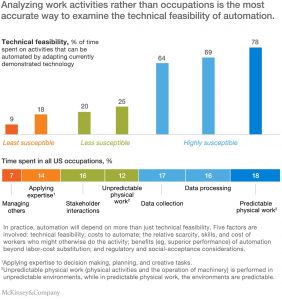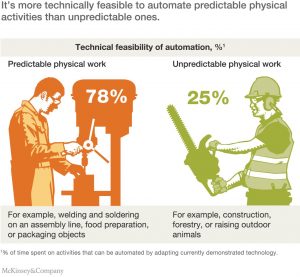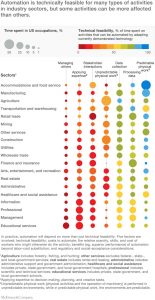As automation technologies such as machine learning and robotics play an increasingly great role in everyday life, their potential effect on the workplace has, unsurprisingly, become a major focus of research and public concern: Which jobs will or won’t be replaced by machines?
First, the technical potential for automation differs dramatically across sectors and activities, according to a publication in McKinsey Quarterly of July 2016.
The research shows, automation will eliminate very few occupations entirely in the next decade, but it will affect portions of almost all jobs to a greater or lesser degree, depending on the type of work they entail.
Automation, now going beyond routine manufacturing activities, has the potential, as least with regard to its technical feasibility, to transform sectors such as healthcare and finance, which involve a substantial share of knowledge work.
Currently, 45% of the activities people are paid to perform and about 60% of all occupations could see at least a part of their activities automated.
Exhibit 1 lists seven top-level groupings of activities. Occupations in retailing, for example, involve activities such as collecting or processing data, interacting with customers, and setting up merchandise displays.
A second factor to consider is the cost of developing and deploying both the hardware and the software for automation.
The cost of labor and related supply-and-demand dynamics represent a third factor: if workers are in abundant supply and significantly less expensive than automation, this could be a decisive argument against it.
A fourth factor to consider is the benefits beyond labor substitution, including higher levels of output, better quality, and fewer errors.
These are often larger than those of reducing labor costs. Regulatory and social-acceptance issues, such as the degree to which machines are acceptable in any particular setting, must also be weighed. A robot may, in theory, be able to replace some of the functions of a nurse, for example. But for now, the prospect that this might actually happen in a highly visible way could prove unpalatable for many patients, who expect human contact. The potential for automation to take hold in a sector or occupation reflects a subtle interplay between these factors and the trade-offs among them.
Even when machines do take over some human activities in an occupation, this does not necessarily spell the end of the jobs in that line of work. On the contrary, their number at times increases in occupations that have been partly automated, because overall demand for their remaining activities has continued to grow.
The most automatable activities
Almost one-fifth of the time spent in US workplaces involves performing physical activities or operating machinery in a predictable environment: workers carry out specific actions in well-known settings where changes are relatively easy to anticipate. Through the adaptation and adoption of currently available technologies, the technical feasibility of automating such activities at 78%, the highest of the seven top-level categories (Exhibit 2). Since predictable physical activities figure prominently in sectors such as manufacturing, food service, accommodations and retailing, these are the most susceptible to automation based on technical considerations alone.
In manufacturing, for example, performing physical activities or operating machinery in a predictable environment represents one-third of the workers’ overall time. The activities range from packaging products to loading materials on production equipment to welding to maintaining equipment. Because of the prevalence of such predictable physical work, 59% of all manufacturing activities could be automated, given technical considerations. The overall technical feasibility, however, masks considerable variance. Within manufacturing, 90% of what welders, cutters, and solders do, for example, has the technical potential for automation, but for customer-service representatives that feasibility is below 30%. The potential varies among companies as well. Our work with manufacturers reveals a wide range of adoption levels—from companies with inconsistent or little use of automation all the way to quite sophisticated users.
Manufacturing, for all its technical potential, is only the second most readily automatable sector in the US economy.
A service sector occupies the top spot: accommodations and food service, where almost half of all labor time involves predictable physical activities and the operation of machinery – including preparing, cooking, or serving food; cleaning food-preparation areas; preparing hot and cold beverages; and collecting dirty dishes. According to the analysis, 73% of the activities workers perform in food service and accommodations have the potential for automation, based on technical considerations.
Some of this potential is familiar. Automats, or automated cafeterias, for example, have long been in use. Now restaurants are testing new, more sophisticated concepts, like self-service ordering or even robotic servers. Solutions such as Momentum Machines’ hamburger-cooking robot, which can reportedly assemble and cook 360 burgers an hour, could automate a number of cooking and food-preparation activities. But while the technical potential for automating them might be high, the business case must take into account both the benefits and the costs of automation, as well as the labor-supply dynamics discussed earlier. For some of these activities, current wage rates are among the lowest in the United States, reflecting both the skills required and the size of the available labor supply. Since restaurant employees who cook earn an average of about 10 USD an hour, a business case based solely on reducing labor costs may be unconvincing.
Retailing is another sector with a high technical potential for automation. 53% of its activities are automatable, though, as in manufacturing, much depends on the specific occupation within the sector. Retailers can take advantage of efficient, technology-driven stock management and logistics, for example. Packaging objects for shipping and stocking merchandise are among the most frequent physical activities in retailing, and they have a high technical potential for automation. So do maintaining records of sales, gathering customer or product information, and other data-collection activities. But retailing also requires cognitive and social skills. Advising customers which cuts of meat or what color shoes to buy requires judgment and emotional intelligence. 47% of a retail salesperson’s activities have the technical potential to be automated – far less than the 86% possible for the sector’s bookkeepers, accountants, and auditing clerks.
The jobs of bookkeepers, accountants, and auditing clerks, for example, require skills and training, so they are scarcer than basic cooks. But the activities they perform cost less to automate, requiring mostly software and a basic computer.
As automation advances in capability, jobs involving higher skills will probably be automated at increasingly high rates.
Exhibit 3 highlights the wide variation in how automation could play out, both in individual sectors and for different types of activities within them.
Across all occupations in the US economy, one-third of the time spent in the workplace involves collecting and processing data. Both activities have a technical potential for automation exceeding 60%. Long ago, many companies automated their activities: administering procurement, processing payrolls, calculating material-resource needs, generating invoices and using bar codes to track flows of materials. But as technology progresses, computers are helping to increase the scale and quality of these activities. For example, a number of companies now offer solutions that automate entering paper and PDF invoices into computer systems or even processing loan applications.
And it’s not just entry-level workers or low-wage clerks who collect and process data; people whose annual incomes exceed 200’000 USD spend some 31% of their time doing those things, as well.
Financial services and insurance provide one example of this phenomenon. The world of finance relies on professional expertise: stock traders and investment bankers live off their wits. Yet about 50% of the overall time of the workforce in finance and insurance is devoted to collecting and processing data, where the technical potential for automation is high. Insurance sales agents gather customer or product information and underwriters verify the accuracy of records. Securities and financial sales agents prepare sales or other contracts. Bank tellers verify the accuracy of financial data.
As a result, the financial sector has the technical potential to automate activities taking up 43% of its workers’ time. Once again, the potential is far higher for some occupations than for others. For example, we estimate that mortgage brokers spend as much as 90% of their time processing applications. Putting in place more sophisticated verification processes for documents and credit applications could reduce that proportion to just more than 60%. That would free up mortgage advisers to focus more of their time on advising clients rather than routine processing. Both the customer and the mortgage institution get greater value.
Activities with low technical potential for automation
The hardest activities to automate with currently available technologies are those that involve managing and developing people (9% automation potential) or that apply expertise to decision making, planning, or creative work (18%). These activities, often characterized as knowledge work, can be as varied as coding software, creating menus, or writing promotional materials. For now, computers do an excellent job with very well-defined activities, such as optimizing trucking routes, but humans still need to determine the proper goals, interpret results, or provide commonsense checks for solutions. The importance of human interaction is evident in two sectors that, so far, have a relatively low technical potential for automation: healthcare and education.
Overall, healthcare has a technical potential for automation of about 36%, but the potential is lower for health professionals whose daily activities require expertise and direct contact with patients. For example, we estimate that less than 30% of a registered nurse activities could be automated, based on technical considerations alone. For dental hygienists, that proportion drops to 13%.
Nonetheless, some healthcare activities, including preparing food in hospitals and administering non-intravenous medications, could be automated if currently demonstrated technologies were adapted. Data collection, which also accounts for a significant amount of working time in the sector, could become more automated as well. Nursing assistants, for example, spend about two-thirds of their time collecting health information. Even some of the more complex activities that doctors perform, such as administering anesthesia during simple procedures or reading radiological scans, have the technical potential for automation.
Of all the sectors, the technical feasibility of automation is lowest in education, at least for now. To be sure, digital technology is transforming the field, as can be seen from the myriad classes and learning vehicles available online. Yet the essence of teaching is deep expertise and complex interactions with other people. Together, those two categories – the least automatable of the seven identified in the first exhibit – account for about one-half of the activities in the education sector.
Even so, 27% of the activities in education – primarily those that happen outside the classroom or on the sidelines – have the potential to be automated with demonstrated technologies. Janitors and cleaners, for example, clean and monitor building premises. Cooks prepare and serve school food. Administrative assistants maintain inventory records and personnel information. The automation of these data-collection and processing activities may help to reduce the growth of the administrative expenses of education and to lower its cost without affecting its quality.
Looking ahead
As technology develops, robotics and machine learning will make greater inroads into activities that today have only a low technical potential for automation. New techniques are enabling safer and more enhanced physical collaboration between robots and humans in what are now considered unpredictable environments. These developments could enable the automation of more activities in sectors such as construction. Artificial intelligence can be used to design components in engineer-heavy sectors. One of the biggest technological breakthroughs would come if machines were to develop an understanding of natural language on par with median human performance – that is, if computers gained the ability to recognize the concepts in everyday communication between people. In retailing, such natural-language advances would increase the technical potential for automation from 53% of all labor time to 60%. In finance and insurance, the leap would be even greater, to 66% from 43%.
In healthcare, too, technology will become more capable over time. Robots may not be cleaning your teeth or teaching your children quite yet, but that doesn’t mean they won’t in the future.
——–
McKinsey’s Michael Chui explains how automation is transforming work – https://youtu.be/obnZu3FN_VA




 TheLeader Business, Economy, Stock Market, Management
TheLeader Business, Economy, Stock Market, Management
